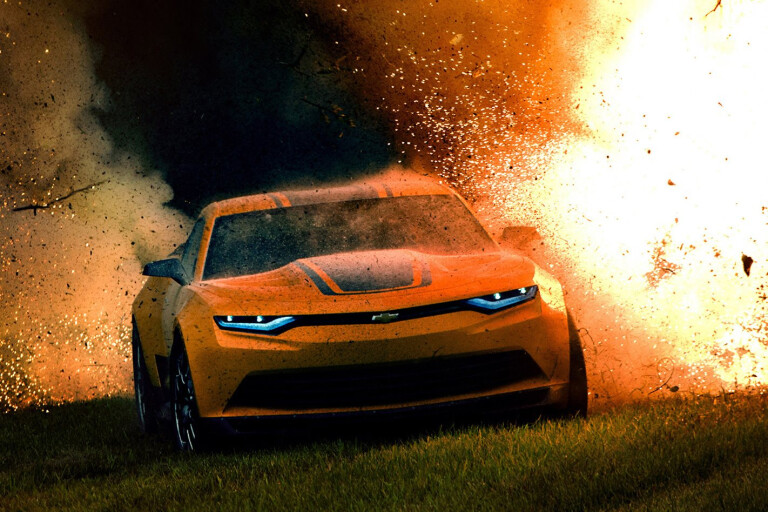
1. LIGHTNING MCQUEEN
Keeping it real.

The great thing about Lightning McQueen is that he’s really a bit of an asshole.
Hollywood has a habit of anthropomorphising things by pouring sugar on them, thus Woody is a nice toy, Nemo is a friendly fish and even Sulley is a good monster.
Lightning, though, is exactly what you’d expect a Nascar racer to be like if it had a personality – loud, arrogant and slightly dim. Underneath it all, of course, is a typically Disney heart of gold, and his thirst for victory at all costs is eventually beaten out of him, as he loses his ‘Stickers’ and ends up looking more like a Corvette than a mean-spirited race car.
The people who penned McQueen were apparently inspired not only by Nascars but sports cars including the Mazda MX-5 – hence the friendly face – and Dodge Viper.
The great thing about the Cars movies is that they do what motoring enthusiasts have always done in their own heads and imbue all kinds of vehicles with personalities; VW Kombis are wasted hippies, tow trucks are toothless red necks, and a Porsche 911 (aka Sally Carrera) is the kind of car you just can’t help falling in love with.
Kids love the Cars movies because they’re cartoony and simple, but grown-ups love the knowing nods to adult world, and the clever one-liners – “thank the manufacturer you’re alive”.
Herbie may have been the first car with personality to light up the big screen, but Lightning McQueen is the greatest, because he keeps it real.
Lightning McQueen wasn’t, as you might have guessed, named after the great Steve McQueen, but after Pixar animator Glenn McQueen, who died in 2002.
Harv, Lightning’s manager (who we never see on screen) is based on the character Ari Gold from Entourage and was voiced by Jeremy Clarkson in the British version of Cars and actor Jeremy Piven in the US version.
2. THE FLINTMOBILE
A modern Stone Age car for a gay old time.

If you can remember The Flintstones – the cartoon, not the execrable movie – you’re officially old, and you’ll definitely be able to sing the first few bars of the theme song. It’s part of our cultural DNA, and far catchier than our national anthem.
The funniest thing about the show, of course, was the car, commonly known as The Flintmobile, which ran on two feet and a heartbeat, if you were alone, but could get up more speed depending how many friends you could jam in. The P-platers in the town of Bedrock must have been a nightmare.
It’s never mentioned on the show, but from the look of those stone wheels we’re willing to bet the ride quality on Fred Flintstone’s car was appalling.
Still, there’s no denying its bottomless, engineless construction was an admirably simple piece of engineering, and it was roomy, too.
It may have escaped your memory that, in the opening credits, the car manages to carry four adults, two children, a pet dinosaur and a sabre-toothed tiger to the drive-in for the evening (with disastrous results for the roof lining).
Fred was obviously a man of means because he also seemed to have a two-seat, roadster version just for cruising the streets, looking for Barney Rubble.
First shown from 1960 to 1966, and then repeated endlessly, US TV Guide rated The Flintstones the Second Greatest TV Cartoon of All Time – after The Simpsons, obviously.
Other cool Stone Age gadgets on the show included a baby wooly mammoth vacuum cleaner, an electric razor made from a clamshell with a bee buzzing inside, and automatic windows powered by monkeys.
3. CANYONERO
The SUV for Homer-phobics.
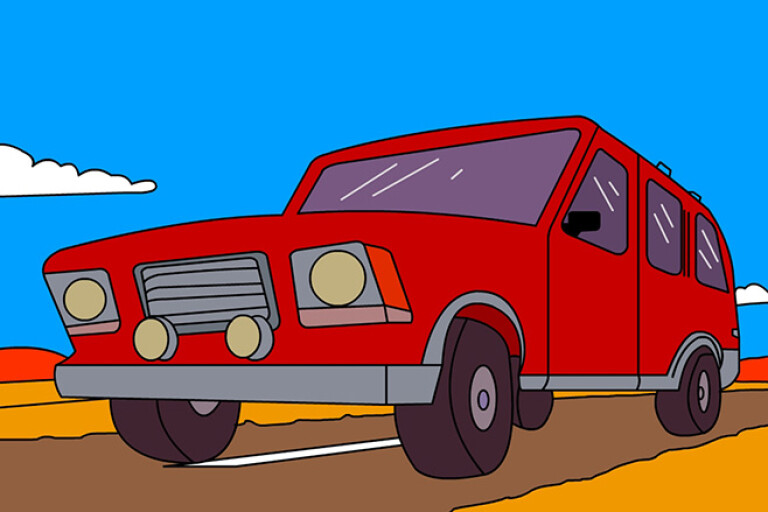
Yes, there are other vehicles on The Simpsons, but none of them have a sales jingle as catchy as Canyonero: “Can you name the truck with four-wheel drive, smells like a steak, and seats 35? Canyonero! Canyonero! Well, it goes real slow with the hammer down, it's the country-fried truck endorsed by a clown. Canyonero!”
A later version of the song, performed by celebrity endorserer, Krusty the Clown, adds the priceless line: “Top of the line in utility sports, unexplained fires are a matter for the courts!”
First seen in the episode Last Temptation of Krust, the Canyonero was The Simpsons’ writers not so subtle skewering of SUV culture in truck-lovin’ Middle America.
Homer later buys a Canyonero, accidentally speccing the F version, which comes with lipstick holders, and then refuses to drive it because he’s afraid it will make him look like a girl.
The car is, according to nerds, a parody of the Jeep Wagoneer, which you could say is itself a parody of Jeep generally.
Those with a real eye for detail, however, point out that Homer’s usual conveyance, a badly battered station wagon, shares a lot of similarities with the Canyonero, which suggests there may be a parody happening within the parodying.
Marge ends up becoming a road-rage monster when she’s forced to drive the Canyonero and then becomes sick with its power. As usual, The Simpsons hits all its targets, right between the eyes.
You can turn your car or SUV into a Canyonero with moulded badges that can be bought online. They were selling for $US15 last time we checked.
The original Canyonero theme song is performed by country and western music star Hank Williams Jnr, who looks like a parody of country singers, and men with beards in general.
4. THE MYSTERY MACHINE
Rolling stoners.
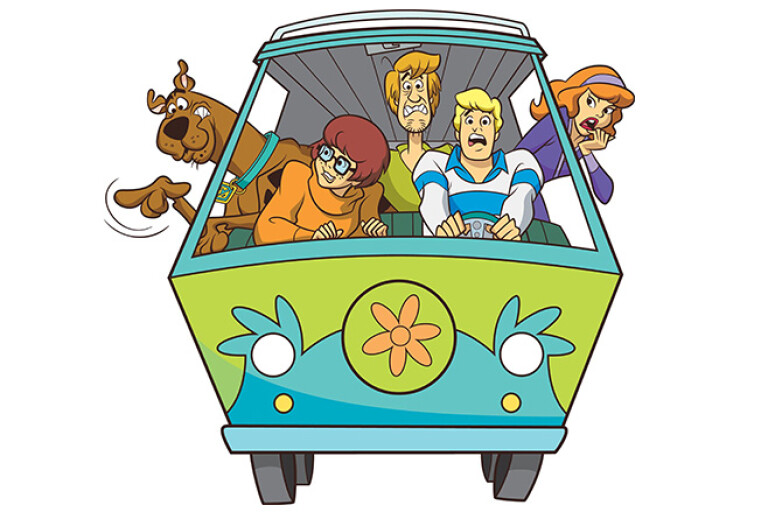
If you pause to consider how many times you watched Scooby Doo as a kid – or how often your kids are watching it now – it must make you wonder just how thick mini-humans are.
Let’s face it, Scooby Doo is a one-trick puppy, with the same plot line – scary looking monster/ghost/werewolf turns out to be one of the three new characters the Scooby gang have met that day wearing a remarkably expensive and effective Halloween outfit – wheeled out in every single episode.
Sure, there was always Daphne to look at, but surely we all should have cottoned on sooner than we did (then again, as a child I also thought the WWF was real for an embarrassingly long time).
Perhaps the Mystery Machine is to blame, because the other TV show that approaches it for predictability was The A Team, which also featured a Chevrolet van, albeit one with a tougher paint job.
The hippy-dippy looks of the Mystery Machine – a modified Chevrolet Greenbrier – are apparently explained by the fact it formerly belonged to a band known as The Mystery Kids, and was painted by the group’s pianist, Flash Flannigan. Don’t beat yourself up if you didn’t know that.
The real mystery of the machine is what’s in the back because it seems to have a Tardis-like quality. It’s also possessed of magical powers, having driven millions of kilometres over the years, including all the way to China in one episode.
You might think the Mystery Machine belongs to Fred, but that’s because you’re old fashioned, or you were when you watched the show. It was, in fact, given to Daphne by her father when she turned 16.
It’s safe to say the drug references in Scooby Doo weren’t an accident. If Shaggy’s not a stoner – and the inspiration for grunge culture – then why is he always so damn hungry? Plus, he thinks his dog can talk.
5. BATMOBILE
Holy batwings!

Clearly, the Batmobile is the ultimate cartoon car, the unreal world’s answer to the Lamborghini Countach, but which one do you see when you think of it?
For me, it’s all about the top pipes, so the Batmobile I dream of is the one from the camptacular TV show.
That car, which managed to look tough despite its mincingly awkward pilots, was based on Ford’s abandoned Futura concept car of 1965, with its crazy fins and bubble canopies. Can’t imagine why Ford gave up on it.
It was the three pipes firing up into the air behind Batman’s mauve-wrapped head that really made it, though.
The TV cartoon version you might be picturing only appeared in the Superfriends series, because Batman didn’t get his own animated show until 1992. Instead, he and Robin had to carry some overhyped, basically useless super heroes, like Wonder Woman, Aquaman and Wonder Dog. We’re not talking Cristopher Nolan’s Dark Knight here.
The Superfriends Batmobile was based on the Futura version driven by Adam West – who has gone on to become an animation star, playing himself as the mayor of Quahog in Family Guy – but was toned down for the cartoon, presumably because it was too hard to draw.
It was also the first Batmobile to feature yellow bat emblems on the door, which were fully sick at the time.
When you actually look at the old Batmobiles, it becomes quite clear that the reason we feel a deep cultural love for this car has more do with how cool it’s looked since the Tim Burton reboot than any childhood memories.
The Batmobile has since undergone some criminally excellent rebirths ever since.
While the Batman comic strip began in 1939, it took two years for the Batmobile to show up, and early versions were very fast and able to smash buildings to bits. Very handy.
The most expensive Batmobile was the one with the crazy pipes from the 1960s TV show.
It was sold for $5.4 million in 2013 to a collector who planned to knock down a wall in his house and park it in his living room.
6. THE JETSONS' FLYING CAR
Blue-sky thinking.
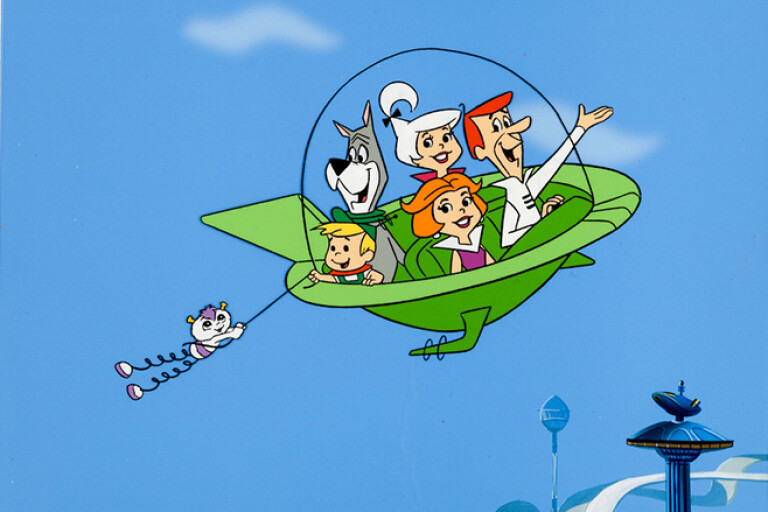
You can argue whether it is, strictly speaking, a car – after all, it only has wheels for landing on, just before it folds away into a brief case – but you’ve seen the words Jetsons Car associated with every newspaper and magazine story you’ve ever read about 'flying cars', right next to the words Back to the Future II, and that’s the name that’s stuck.
A kind of witty non-literary riposte to The Flintstones, or an attempt to cash in on its popularity, The Jetsons aired – in prime time mind you, where we now having cooking shows – in 1962-63, before being reborn by Hanna-Barbera from 1985 to 1987.
The car is such a sticky memory from the show because it was the star of the opening credits, with George dropping “his boy Elroy” and family off around Orbit City – popping each of them into tubes that are then ejected as George drives on and simply fly themselves to school or the shops – before taking him to work.
We’re lucky to catch George Jetson on this day of his schedule, of course, because in the future – no year is specified, but it’s thought to be either 2000 or 2062 – he only has to work an hour a day, twice a week.
Undeniably the car’s greatest feature is that George can keep it on his desk in a briefcase that doesn’t even look particularly heavy. Now that would solve the parking problems in our CBDs quick smart.
Rosie was the Jetsons’ household robot, a slightly outdated model who clearly inspired the work of Alice in The Brady Bunch. With robots set to become commonplace before 2030, who’s to say we won’t all have a Rosie looking after us by 2062?
People love the sound of the Jetsons’ Car so much you can download it as a ring tone, or debate how it was made if you frequent lonely chat rooms. One theory is that it was made by “putting the muzzle of a pop gun into a cider jug and pulling the trigger”.
7. THE MEAN MACHINE
Jet-engined dart for dastardly deeds.
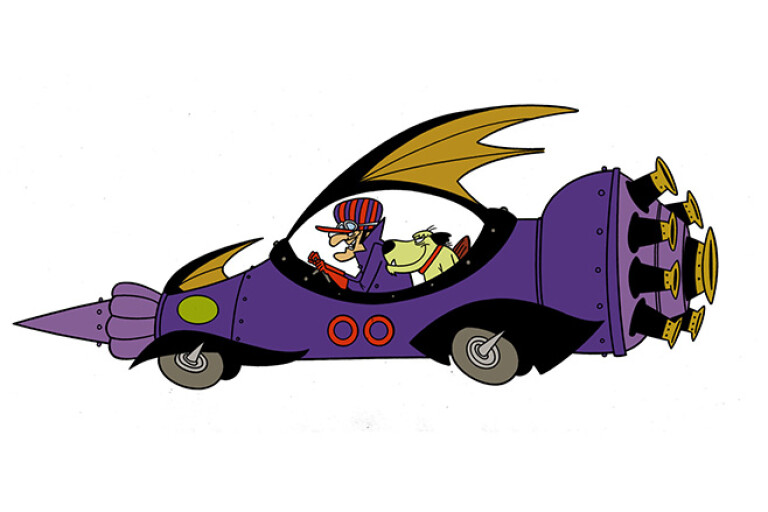
Many a modern motor sport entity brings to mind the work of the legendary Dick Dastardly, who would do whatever it took to win the Wacky Races, and damn the consequences.
Unlike Michael Schumacher, however, Dastardly and his Mean Machine never actually won. Well, they did, once, but the judges demanded the footage be reviewed and then tampered with it to make it look like Dick had cheated, handing the race to the ever-lovely Penelope Pitstop.
This was deeply amusing to those of us glued to our screens when Wacky Races was on high rerun rotation in Australia in the 1980s (the original was first aired in the US in 1968-69).
Despite having a rocket-powered car that was clearly the fastest thing in a fairly ordinary field, and which was also packed with evil tricks for the “double-dealing do badders” – Dick and his whine-up laughing dog, Muttley – the bad guy always failed. His comeuppances were always accompanied by catchphrases like “drat, drat and double drat”, “curses, foiled again” and “Muttley, do something!”
While it looked like a feathered dart with a rocket shoved up its arse, or a sporty mardi gras float, the Mean Machine was a fabulous villain and part of an unforgettable show, the wheeled characters of which could fill most of the 12 positions on our Cartoon Cars list.
Wacky Races was inspired by the film The Great Race, with Dastardly based on the character of Professor Fate, played by Jack Lemmon in the movie.
Dick Dastardly, with a lot of help from Muttley was so popular he was given his own spin-off show, Dastardly and Muttley in Their Flying Machines, which unwisely moved away from the car-racing theme. Just not Wacky enough.
8. BUMBLEBEE
Flowering superhero.
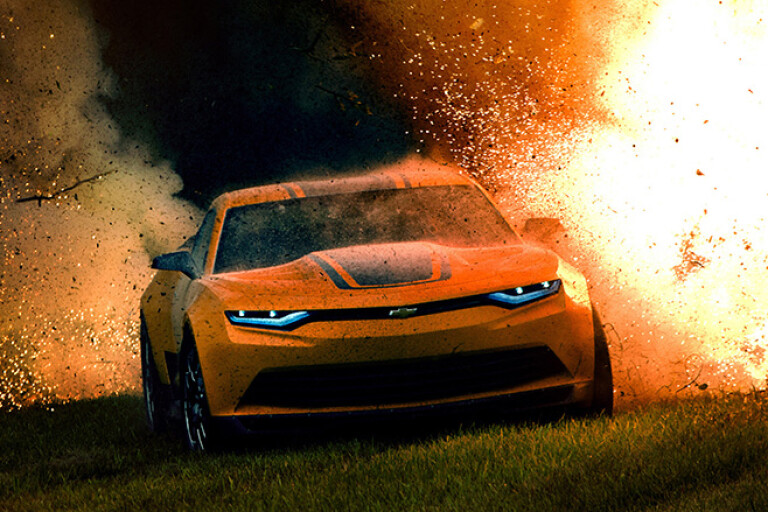
Forget millionaire Michelle Bridges and the lycra-wearing cross-fit cultists, if you really want to change your body for the beefier, just get yourself cast in a Michael Bay movie.
Just look at Bumblebee. In the original animated Transformers series – with its unsettlingly catchy theme tune – Bumblebee was, as his slightly effete name suggests, a bit flower-powered. Yes, that’s right, when he wasn’t being the desperate little brother of the Autobots cool cadre (how boss was Optimus Prime?), Bumblebee could transform himself into a pleasant yellow Volkswagen Beetle.
Which is almost literally a million miles away from what he looks like in Bay’s Transformers films, where he’s transformed into a Chevy Camaro that’s by far the hottest character in the franchise. Hopefully the director got some kickback from Chevy as well because he beefed the hell out of the Camaro’s image.
Things did get better for the cartoon version of Bumblebee in later series, of course, where he became a kind of motor show concept version of a Suzuki Swift, with rockets in his roof. During this phase he did try and establish hard-car cred for himself by engaging in some illegal street racing, organised by a character called Master Disaster (a good name for Michael Bay, funnily enough) which exposed just how slow this cutesy compact was.
The movie version of Bumblebee that we all now know and love, of course, is even faster than a Michael Bay explosion.
As far as we can deduce, Bumblebee seems to be something like four million years old. It seems unlikely that he’s still covered by a warranty, certainly not a Chevrolet one.
At some stage in Transformers history too dull to recount in detail, both Optimus Prime and Bumblebee had to be rebuilt, by the “Quintessons”, leaving Bumblebee looking like a “gold bug”. Prime decreed that this would be his new name – Goldbug.
9. THE MARK III
Danger on the roads.

Prepare to have your world rocked; Penfold, the mild and myopic sidekick of the legendary Danger Mouse, is not a mole. According to the writers of this fantastically successful animated series, which first ran in the UK from 1981-92, Penfold, first name Ernest, is a hamster.
Mainly, though, we remember him as a scaredy-cat (his codename was “The Jigsaw” because he goes to pieces so often) squealing his catch phrases of “Crumbs, DM!”, “Ooh-eck” and “Ooh, carrots”, particularly when his boss was frightening the hell out of him in The Mark III.
This flight-capable car – wings extend telescopically from the sides when Danger Mouse presses a button on his Dick Tracy-like wrist controller – was small and darty, like a finch, although probably smaller.
It was invented for DM by Professor Heinrich Von Squawkencluck and was often used in the pursuit of everyone’s favourite mad villain, Count Duckula, and Baron Silas Greenback, of course.
You probably didn’t notice it back when Danger Mouse was on high rotation on the ABC (and then Channel Ten) as a post-school staple, but a lot of the shots of the Mark III flying were used again and again. Because each 10-minute episode required more than 2000 time-consuming drawings, the creators became experts at economising and recycling, even setting many episodes at the North Pole, because the backgrounds required so little detail.
Despite its cheap and cheerful approach, it was hugely successful, watched by more than 21 million people in the UK in 1983, and becoming the first animated British series to break into the American market.
The man who wrote the catchy and much-mimicked theme tune – feel free to hum it in your head now – was Chuck Lorre, the evil genius who produces Two and a Half Men and The Big Bang Theory.
A new version of the show is due to hit our screens this year, with Alexander Armstrong taking over the voice of Danger Mouse, previously played by esteemed British actor David Jason.
10. THE SHELLRAISER
Heroes in a half van.
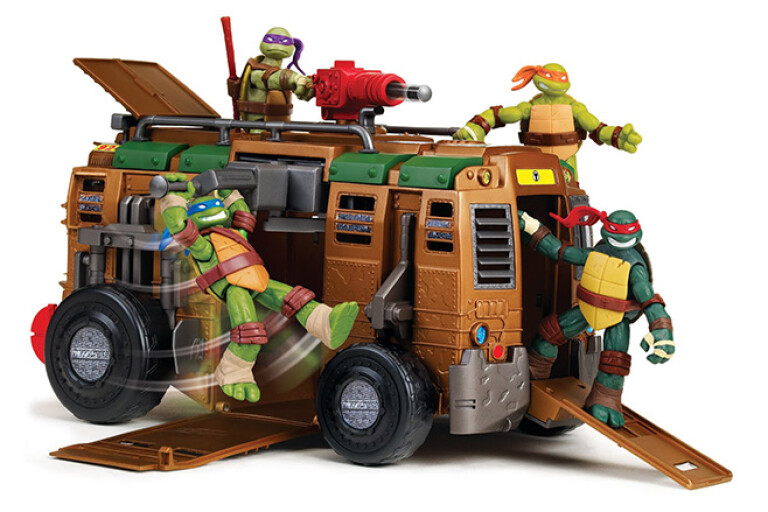
In the case of some cartoons, we’re asked to suspend disbelief on a fairly grand scale – I’ll buy that a mouse could be smart enough to pilot a flying car, but outsmarting bad guys as well is a bridge too far.
Funnily, though, we never even question whether a mutated turtle in the grips of its testosterone-fuelled crazy puberty years would be able to drive a van, perhaps because everything else about the plot of Teenage Mutant Ninja Turtles is so bonkers that this seems minor.
The original TMNT cartoon was so popular in the late 1980s and early 1990s that it was on five nights a week in markets around the world. And yet, despite the drain on the clearly acid-fried writing team that this must have caused, quality never wavered.
Until the live-action movie versions started, that is. It’s been downhill from there, although a three-year-old boy recently sang me the line that Michelangelo is a party dude, so it continues to succeed, or at least sell toys.
So you can get a toy version of the Shellraiser – it deserves to be here for its name alone – which is a van made by the annoyingly clever Donatello.
Fashioned from an abandoned subway car (they live in the sewers, remember, and yet April never complains about the smell), it has the ability to drive on either railway tracks or roads and has a Trash Cannon on the roof, a back-door cannon and a big chomping mouth at the front.
Plus, you can launch a Stealth Bike out the rear, which is so Batman it hurts.
Leonardo, obviously, is the driver of the Shellraiser, because he leads, and others follow.
Yes, the Shellraiser is pre-dated by the less exciting sounding Turtle Van, but they even let April drive that sometimes. Much like the Batmobile, the original was not the best.
TMNT fans will tell you, if you let them, that the Shellraiser at some point morphs into The Party Van, after being given a makeover by the wild, crazy and pizza-loving Michelangelo. Obviously.
11. ECTO-1
We ain't afraid of no ghost.
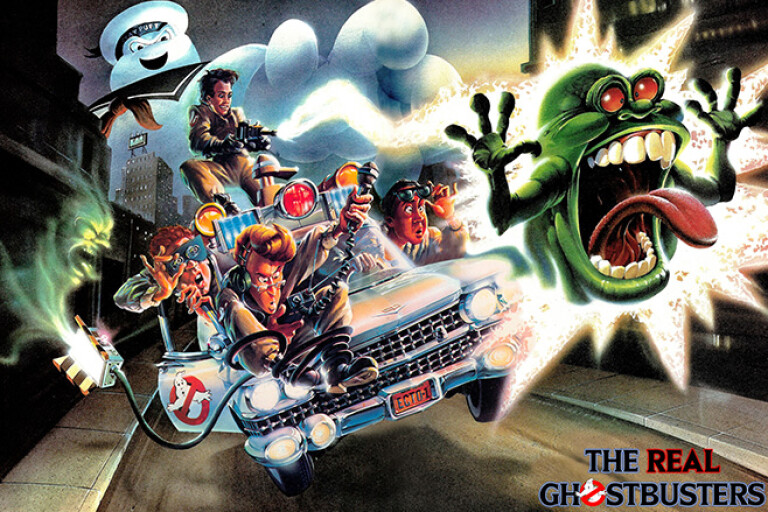
Everything about Ghostbusters was great, from the lowest slime to the highest Stay Puft Marshmallow man. It was, perhaps, the great Bill Murray at his greatest.
The car in the excellent films was an ambulance/hearse based on a 1959 Cadillac chassis, and was bought by Dr Ray Stantz (Dan Aykroyd, also amazing) shortly after he mortgaged his mother’s house to buy the Ghostbusters a fire house to work from, and it looks very much the same in The Real Ghostbusters, the cashing-in cartoon version that ran for five years from 1986, and even won an Emmy Award.
The Ecto-1 gets more of a dramatic role in the cartoons, being used for racing by Winston (originally supposed to be played by Eddie Murphy, but he pulled out and the role was shrunk down) and fitted with Ghostbusting gadgets like a cannon that takes out “larger entities”, a lassoo-firing thing, a smoke machine and a Jet Jumper, which allows it to do a proper kangaroo hop, 2m straight up.
The creative geniuses behind the original films may not have been heavily involved in the cartoon version, but it did feature almost-star Arsenio Hall, in the role of Winston. And it does, supposedly, cover the events immediately after the movie, when it turns out Slimer the ghost becomes their good friend, and that the Stay Puft Marshmallow Man didn’t entirely melt after they blasted him.
The only actor from the film who wanted to be in The Real Ghostbusters was Ernie Hudson, who played Winston, but the role was given to Arsenio Hall instead. Showbiz is cruel.
A new movie is due next year, but all the Ghostbusters are now women. Dan Aykroyd has talked up the cast, including Melissa McCarthy and Kristen Wiig, but then he wrote the original and might be getting paid.
12. THE CREEPY COUPE
Wackiest racer of all.
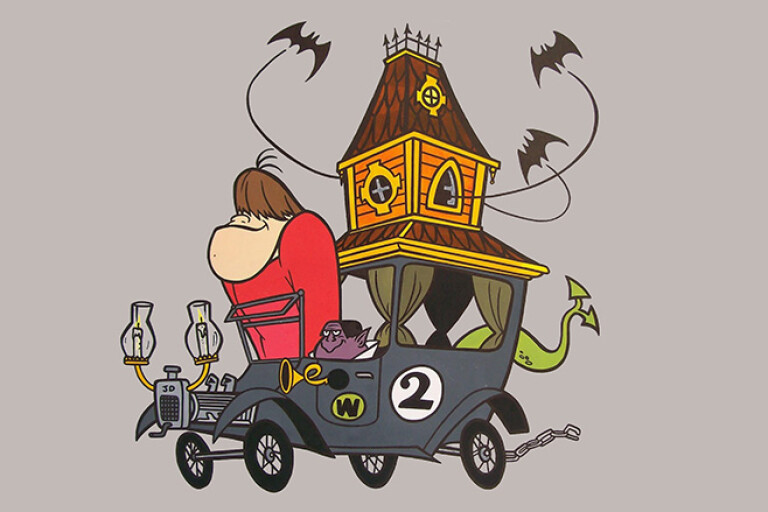
The cars in Wacky Races really deserve more than one mention, and after debating the many merits of Penelope Pitstop’s Compact Pussycat and Professor Pat Pending in the Convert-a-Car, we’ll go with The Creepy Coupe.
This fabulous hearse, with actual bats in its actual belfry, was such a big part of Wacky Races I actually thought it was a show of its own.
The Creepy Coupe’s belfry also contains ghosts, giant serpents, a dragon and various other nefarious types. It's driven by Big Gruesome and Little Gruseome, who is a vampire, and also the brains of the outfit. What Big Gruesome is supposed to be is hard to deduce, but there’s certainly a lot of whatever he is.
The Gruesome Twosome are, of course, evil bastards and a counterfoil to the counterfoil that is Dick Dastardly. Having your dragon breathe fire on anyone stupid enough to overtake you is a powerful racing manoeuvre.
The Creepy Coupe sticks in the mind, I think, because it chimes with that weird obsession with macabre stuff we had, from The Addams Family to The Munsters and even Scooby Doo.
Putting a haunted house on wheels was, typically, an act of genius from Wacky Races.
Don Messick, who also played Muttley and Scooby Doo, was the voice of Little Gruesome, while Big Gruesome sounded like Boris Karloff and was voiced by Daws Butler, who was also Yogi Bear.
Another handy bonus from having a dragon live upstairs in your creepy house on wheels is that you can, from time to time, fly short distances, if the dragon can be bothered with all the flapping.
This article was originally published in Wheels June 2015.
COMMENTS